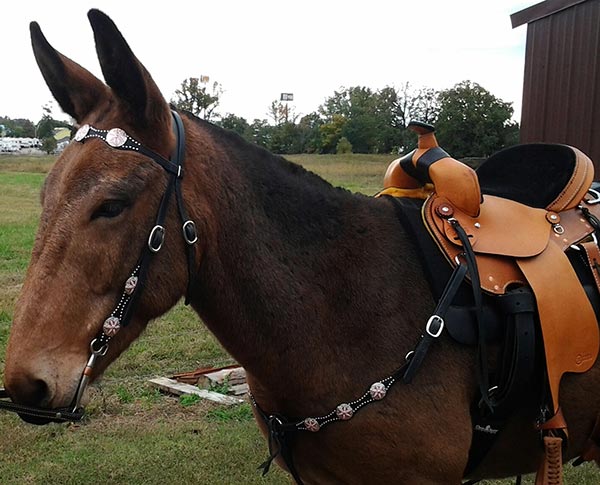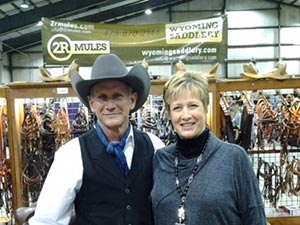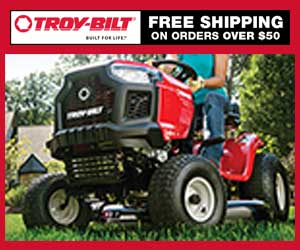
by Roger and Rhonda Adams, Owners 2Rmules and Wyoming Saddlery
The Answer is YES!
Many folks ask us "Why do I need a Mule saddle?” “What’s the difference between a horse and a mule saddle anyway?"
These are great questions and the answers will help ensure the comfort of your mule for years to come.
The difference in conformation between the mule and the horse is what requires a different saddle tree. The mule takes on many of the characteristics of the donkey; a straight back with low or no withers. While not all mule backs are as straight as the traditional donkey, they still have a very flat back in comparison to the horse. A horse saddle will need "rock in the bars." Rocking refers to the curve in the tree from the front to the back of the bar. Think of a rocking chair. Although in a saddle tree the curve is not as pronounced - the principal remains the same and the comfort of your equine partner is the goal. When you put a horse saddle on a mule, you will notice that it will rock back and forth and when you tighten the front cinch it will cause the rear of the saddle to rise up off the mule’s back. This is because of the rock in the bars which is a standard feature in most horse saddles.
In the same way that we may need to try on several outfits, looking for the perfect fit, the same is true for the saddle fit on our mules. The good news is that 2Rmules and Wyoming Saddlery builds every tree individually. We have created a simple-to-use custom tree fitting program that any mule owner can take advantage of as long as you have a cell phone camera and can send us a few photos along the way. More on this later.
Beyond the “rock in the bars,” which impacts how well the saddle fits your mule from front to back, there is the issue of the width of the gullet and the angle of the bars that will vary, depending on your mule’s build. In the same way that people are all different sizes and shapes, so are our horses and mules. They each have unique backs depending on the breed, the amount of exercise, how much they are fed and whether or not they are easy keepers. For this reason not all mules need the same bars or even the same gullet or barspread. That’s the value of having a custom designed tree for you mule’s saddle. Getting the right fit is now easier than you may think.

Some mules will need just a little rock in the bars while others will need more, and this also applies to the gullet width. When it comes to the gullet, we have heard that you either need a wide gullet or a narrow gullet and nothing is mentioned about the angle of the bars, so let me explain the difference. The gullet width determines how close the saddle sits to the withers and the bar angle is what determines how well the saddle fits on your equine. When the angle is too steep, the bottom edge of the bars will be the only point of the bar making contact with your horse or mule. A wide angle will set on the top part of the bar and that is what is making contact with the back and the bottom will gap. We strive to get as much of the bar as possible making contact from the front of the tree all the way to the back. This way the weight is distributed evenly. Horses and Mules both may need some flare on the front and rear of the bars so not to dig in as they move.
Proper saddle placement is very important to ensure the saddle is setting in the natural pocket of the equine’s back. If it is positioned too far forward on the shoulders it will hinder their front end movement and sitting too far back will hinder the hind quarters. On a horse a good fitting saddle will naturally settle into the pocket in the proper position unless it is held out of place with a breast collar, crupper or britchen. Whereas on a mule, there is less wither to help hold the saddle in place, so you may need the crupper or britchen to keep the saddle from sliding forward which would endanger you and your mule. Pay attention to the way your mule or horse move when saddled because they will tell you by their actions how the saddle is fitting.
You may have a perfectly fitted saddle but still have dry spots and white hairs because we have a tendency to over tighten the front cinch, thinking that it will keep the saddle from sliding around. What that actually does is put too much pressure on the front of the saddle causing it to dig into the animal’s skin. The solution is to use a quality pad under your saddle so you don’t have to over tighten that front cinch. A good quality pad will help keep your saddle in the correct position while also helping to keep your equine comfortable and able to move without restriction. Be sure to look for saddle pads made form all-natural materials.
The reason we make our own trees and offer a custom tree fitting program is to get the best fit possible for your equine. We want your equine partner to be comfortable under saddle so they can enjoy the ride as much as you do. The path to a great fitting saddle is now simpler than you might think. As part of our custom tree fitting program, we will ask you to take a couple of pictures of your horse or mule and email them to us. Then we will send you a tree that will be close to what is needed to build your saddle. After that, we just need three follow-up pictures with that tree on your equine in order for us to create your saddle. We load this information into our program that shows us where and how much adjustment to make to the tree so that it will fit your horse or mule comfortably.
Our goal at 2Rmules and Wyoming Saddlery is to ensure that you and your equine partner ride in comfort for years to come.
Roger and Rhonda Adams, Owners 2Rmules and Wyoming Saddlery. Find them in our section on English & Western Tack.
































